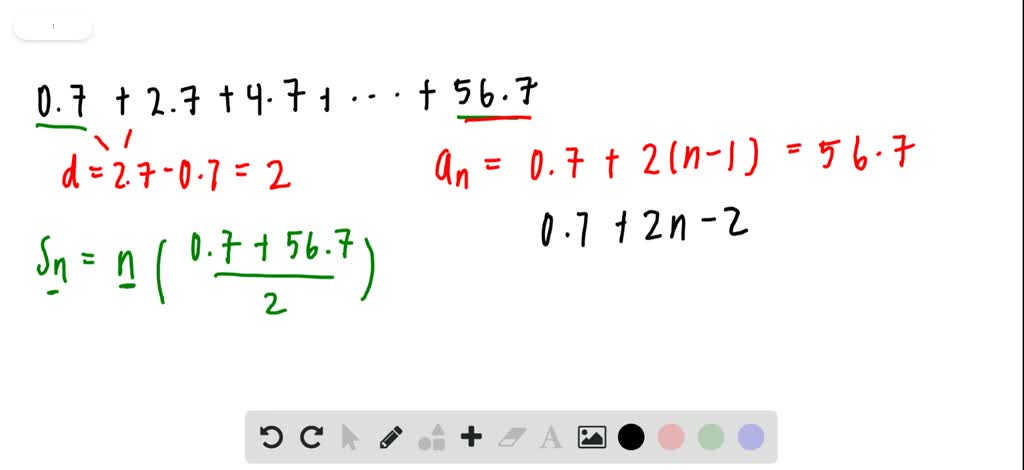

Find the sum of arithmetic sequence or arithmetic series. Arithmetic Sequences (solutions, Examples, Videos, Worksheets, Activities) arithmetic sequence term sequences nth number examples formulas geometric solutions following formula numbers finding rule give list.
#SUM OF ARITHMETIC SEQUENCE PLUS#
The sum of a finite arithmetic sequence can be found using the following formula, Lesson 1 : Sequences, Arithmetic Sequence Find the common difference. progression arithmetic sum terms plus given progressions class solutions solved arithematic ncert topper.

The constant is called the common difference ( ).
#SUM OF ARITHMETIC SEQUENCE SERIES#
We can find the sum of an arithmetic sequence or the value of an arithmetic series by finding the average of the first and the last term then multiplying the result by the number of terms. Arithmetic sequence is a list of numbers where each number is equal to the previous number, plus a constant.

For example, 2 + 5 + 8 = 15 is an arithmetic series of the first three terms in the sequence above. Some sequences are composed of simply random values, while others have a definite pattern that is used to arrive at the sequences terms. Thinking Skill: Explicitly assess information & draw conclusions. The only difference between arithmetic sequences and series is that arithmetic series reflects the sum of an arithmetic sequence. where, an a n n th term, a1 a 1 first term, and. Arithmetic sequence vs arithmetic seriesĪn arithmetic series is the sum of a finite part of an arithmetic sequence. The arithmetic sequence formula is given as, Formula 1: The arithmetic sequence formula is given as, an a1 +(n1)d a n a 1 + ( n 1) d. This formula allows us to determine the nth term of any arithmetic sequence. Therefore, the 100th term of this sequence is: (hint: use the formula for arithmetic sequences first to find n) a. Using the above sequence, the formula becomes: Graph Function 1d from above on the graph provided. Where a n is the n th term, a 1 is the initial term, and d is the constant difference between each term. Fortunately, the nth term of an arithmetic sequence can be determined using This is simple for the first few terms, but using this method to determine terms further along in the sequence gets tedious very quickly. To expand the above arithmetic sequence, starting at the first term, 2, add 3 to determine each consecutive term. For example, the difference between each term in the following sequence is 3: In general, the nth term of an arithmetic sequence is given as follows: an am + (n - m) d Arithmetic Formula to Find the Sum of n Terms An arithmetic series is the sum of the members of a finite arithmetic progression. We can calculate the sum of N terms in the arithmetic equation using this formula in python as follows. Subsequently, the sum of N terms of the arithmetic sequence will become N ( (2A1+ (N-1)D)/2). a_n$, then we can add the first and last term, the second and second last term, etc., to quickly find the sum based on the number of terms.Home / algebra / sequence / arithmetic sequence Arithmetic sequenceĪn arithmetic sequence is a type of sequence in which the difference between each consecutive term in the sequence is constant. Sum of the First n Terms of an Arithmetic Sequence Suppose a sequence of numbers is arithmetic (that is, it increases or decreases by a constant amount each term), and you want to find the sum of the first n terms. Hence, the average of all the numbers in the arithmetic sequence will become (2A1+ (N-1)D)/2. If we have the sequence $a_0, a_0 + x, a_0 + 2x.

Let $a_0$ be the first term, $a_n$ be the last term, and $x$ be the difference between each term. I'm attempting to derive a formula for the sum of all elements of an arithmetic series, given the first term, the limiting term (the number that no number in the sequence is higher than), and the difference between each term however, I am unable to find one that works.


 0 kommentar(er)
0 kommentar(er)
